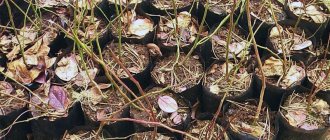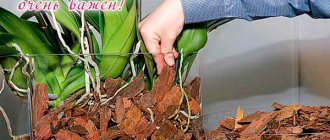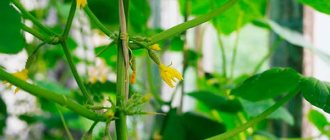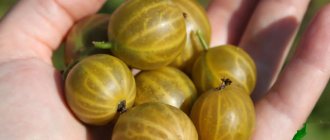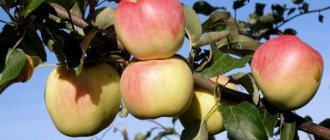Rosa Kordes - what kind of garden group is this, the history of creation
Rosa Cordes is a young group that appeared thanks to the varieties Rugosa and Vihurayana. The founder of this species was the head of the Kordes company; it was one of the ten best rose nurseries around the world. This company still has many varieties and hybrid inflorescences today.
Brief description of the nursery, characteristics
The Kordes nursery is a well-known organization that has become famous for the production of seedlings, crossing different varieties of roses and breeding new types of inflorescences. The organization began its existence in 1887; its founder was Wilhelm Cordes. The descendants of the gardener continued the work they started, and for more than 100 years the organization has been engaged in the selection and propagation of greenhouse roses.
Rosa Cordes
Description and distinctive features of Cordes roses
The first pink hybrids, bred by the German breeder V. Cordes in the century before last, laid the foundation for several lines of these flowers, which have now developed into a real conveyor belt for the production of some of the best pink varieties in the world.
By crossing the pink varieties available at that time, the breeder solved the problem of creating flowers that would not be afraid of cold, diseases, or pests, while maintaining a beautiful appearance and delicate aroma. And he succeeded to the fullest.
- Cordes roses are distinguished by:
- persistent resistance to diseases and pests;
- ability to withstand low temperatures and sudden changes;
- the formation of powerful bushes reaching a height of up to 3 m;
- lush leaf cover of dark green color with shiny leaf blades;
- large multi-flowered double inflorescences;
- ability to bloom continuously until late autumn.
Did you know? Japanese breeders had to spend 14 years of hard work and $28 million to grow blue-violet roses.
Varieties of roses of the Cordes group
Cordes roses come in many different varieties and types of plants. The most common of them are distinguished not only by their pleasant appearance, but also by high frost resistance and good immunity. A brief description of popular groups is presented below.
Floribunda
Rose Coffee Break - description of the bush variety
The variety was obtained by crossing muscat rose, tea rose and polyantha rose. Floribunda is a fairly unpretentious, resistant plant that has good immunity and a long flowering period. This type of rose blooms in summer, the dormant period begins in late autumn.
Important! Inflorescences are often used to decorate rooms and create gift bouquets.
Hybrid tea
One of the most popular groups. It has a delicate aroma, good winter hardiness and many pests, and a long growing season. Hybrid tea inflorescences come in a variety of shapes and shades.
Ground cover
Ornamental plants that are used to improve the territory. The growing season occurs at the beginning of summer, ending in early autumn, with the first cold weather. This group of roses is easy to care for. It does not tolerate severe frosts, so it is not suitable for growing in regions with harsh climatic conditions. Flowers require feeding during the dormant period, as well as shelter from frost and precipitation.
Climbing
Inflorescences used to improve the dacha area. The name of roses speaks for itself - this species is distinguished by small flowers that grow in small groups and weave around placed supports. Roses require care in winter and preparation for cold weather.
Climbing Cordes flowers
Park
Park roses are lush inflorescences with up to 150 petals on one bud. Park rose bushes can grow up to 150 cm in length. These plants smell pleasant, bloom in summer and are distinguished by a variety of color shades and shapes.
Uncovered, continuously flowering varieties
Conventionally, varieties of roses are divided into several categories. They differ in the growth characteristics of shoots and buds.
Climbing
The most popular varieties of uncovered roses of continuous flowering:
- Aisha. Frost-resistant plant with resistance to powdery mildew and gray rot, which does not require shelter for the winter. It is a densely leafy and fairly voluminous shrub up to 1.5 m high. It blooms profusely and for a long time, but only once. The flowers are medium-sized, 6-7 cm in diameter, simple, in a rich sunny shade. They withstand rain well and retain their shape. Externally they resemble rosehip flowers.
- Frühlingsduft. Belongs to the group of wild roses and park roses. It withstands severe frosts well, does not require shelter for the winter, and is not susceptible to powdery mildew or black spot. The bushes reach 2 m in height, spreading, 1.2 m wide. The flowers are creamy-white, with a pink tint and a yellow center, and are formed early. Repeat flowering is possible from May to August.
- Parade. Belongs to the Climing group, the class of large-flowered roses. Requires support, since the height of the bush reaches 4 m and width - 2 m. Flowering begins in mid-June and continues until the 20th of October. The flowers come in a variety of shades, from hot pink to cherry red. The bush can withstand frosts and long rains. Resistant to black spot and powdery mildew.
Climbing roses die without support: the shoots, under the weight of the buds, bend to the ground and rot. Therefore, experienced gardeners create arches and walls from sustainable materials.
Semi-climbing
These roses look good in single and group plantings, but are rarely used among flower growers and landscape designers.
Prominent representatives of plants:
- Ave Maria. Refers to hybrid tea varieties of re-blooming roses. The flowers are bright orange, reaching 11-12 cm in diameter. The plant takes root well in northern regions, is resistant to powdery mildew and black spot, and is not afraid of prolonged rains.
- Aelita. Large-flowered white rose. Developed by Russian breeder Shtanko I.I. in 1952 specifically for cultivation in regions with harsh winters. Resistant to gray rot, not afraid of high humidity.
- Mermaid. Large-flowered, produces carmine-colored flowers with a salmon-orange tint and a yellow base. Well suited for growing in cold climates. The shoots reach 3 m and develop well in shade and partial shade.
Bush
Flowers in this category are formed by bushes. Which bush roses to plant in your dacha so that they bloom all summer long:
- Romance. A shrub with large crimson flowers (up to 12 cm in diameter) and a pleasant aroma. The clusters contain up to 15 buds. The rose blooms again. The foliage is lush, the shoots are densely spaced.
- Gartentraume. A shrub with double flowers and a very pleasant aroma. Looks good in group planting, as a hedge. Suitable for growing in flowerpots. The flowers are pale pink, often located on stems.
Small and large flowered
Many gardeners pay attention to the size of flowers. Some people prefer to admire small roses, others prefer lush and large ones.
Some popular long-flowering varieties and hybrids:
- Super Excelsa. Small-flowered bush rose. The flowers are bright crimson, reaching only 4 cm in diameter. The plant does not like the scorching sun, so it is planted in partial shade.
- Polka. Large-flowered bush rose with apricot or soft coral flowers. Their diameter ranges from 25 to 30 cm. The plant blooms all summer, 2 or 3 times.
- Super Dorothy. Bright crimson small-flowered semi-climbing rose. It blooms at the end of May, pleasing with bright buds until mid-October. Excellent resistance to powdery mildew and black spot.
Miniature
These are small copies of garden roses. They have lush, long-lasting flowering until late autumn.
The plants are suitable for growing in cold climates, in the garden or at home.
Prominent representatives:
- Los Angeles. A bush up to 40 cm high, with salmon-colored flowers with a diameter of 4-5 cm. The buds evenly cover the stems and do not fade in the sun.
- Clementine. Ground cover rose with small, densely double flowers of a soft pink hue. The height of the plant is 60 cm. Over time, the plant turns into a dense bush. Blooms in mid-June and continues to bloom until September.
- Cinderella. Hybrid tea rose with soft pink flowers. The bushes are compact, no more than 20 cm high. They bloom 2-3 times per season. Well suited for creating an alpine slide.
The most popular varieties with a brief description
Garden begonia in a flowerbed - planting and care
Among the most popular varieties of Cordes roses are:
- Alchemist. An interesting look that changes color depending on the temperature outside or indoors. It is grown in the form of bushes reaching 3 m in height. Flowers are distinguished by abundant branching.
- Blue Boy. A dwarf inflorescence reaching a height of up to 50 cm. Blue Boy can be distinguished by its lilac hue and a large number of flowers on the bushes.
- Angela. A rose that blooms in caps. Its flowers are red buds with a pink center. Angela is considered an unpretentious variety, characterized by resistance to high temperatures.
Important! All plants have a pleasant aroma and beautiful appearance.
Canadian roses Explorer series
Without exception, all the best varieties of Canadian roses from the Explorer group are hybrids based on Cordes flowers. All of them bear the names of famous explorers who conquered the north of the planet.
The most frost-resistant and fragrant varieties that can bloom even without shelter for the winter are:
- Henry Hudson. The Canadian park rose Henry Hudson has white flowers with a red coating. The height of the bushes reaches a little more than half a meter, and in diameter - no more than 1 meter. It is resistant to many diseases. The variety was developed in 1966. Its peculiarity lies in the ease of propagation by cuttings - they take root very easily in the soil.
- David Thompson. The variety was created in 1971. Fragrant crimson flowers rise on shoots, about 1.3 m long. Lush buds (about 25 petals) look very beautiful. They bloom for a long time, all summer and autumn.
- Jens Munk. The description of the Canadian rose variety says that Jens Munk has the strongest root-stem system. Thus, a powerful bush is formed, up to two meters high. Pink flowers, the diameter of which does not exceed 7 cm, have a persistent aroma and a beautiful shape.
- Charles Albanel. As summer residents note, these flowers are very beautiful and in demand. It is very easy to buy seedlings of Canadian roses Charles Albanel. This can even be done via the Internet. Charles Albanel is one of the shortest frost-resistant varieties. Their height reaches a little more than half a meter; in appearance, the bush resembles the ground cover species of this plant. The period of active flowering occurs at the beginning of summer and continues until the first frost. The flowers on the bush do not grow densely, but have a very attractive appearance and shape.
- Martin Frobisher. Rose Martin Frobisher (Canadian park) looks good in original landscape solutions. It is often planted in city flower beds because it is not whimsical and does not require care. In some parks, these flowers are used to create hedges to highlight the lines of the seating area. The height of the bushes reaches 2 m. The light red flowers of the Canadian rose Martin Frobisher are very fragrant and lush, each bud has about 40 petals. It should be noted that the Martin Frobisher rose variety is the first breeding development in the Explorer group.
Among all the roses in the Explorer series, there are also three main subgroups:
- Park bush.
- Champlain.
- JPConnell (J.P. Connell).
- Royal Edward (Royal Edward).
- Alexander MacKenzie (Alexander McKinzie).
- Frontenac (Frontenac).
- Simon Fraser (Simon Fraser).
- George Vancouver (George Vancouver).
- Lambert Closse (Lambert Closse).
- Louis Jolliet (Lewis Joliet).
- Climbers.
- John Davis (John Davis).
- Henry Kelsey (Henry Kilsey).
- John Cabot (John Cabot).
- William Baffin (William Baffin).
- Captain Samuel Holland (Captain Samuel Holland).
- Rogusa.
- Henry Hudson (Henry Hudson).
- Charles Albanel (Charles Albanel).
- Jens Munk (Jens Munk).
- Martin Frobisher (Martin Frobisher).
- David Thompson (David Thompson).
Generally speaking, most of the flowers in this group are complex hybrids. Their breeding is closely related to the flowers of Cordes (Rosa kordesii). According to reviews, roses of Canadian selection (frost-resistant varieties) do not need to be covered for the winter. But it has been noticed that after sheltering, they bloom more profusely and longer.
Growing a flower, how to plant Cordes roses correctly
Rose Munstead Wood - description of the varietal plant
To get a good result, you need to follow the rules of planting and caring for planted crops. This principle will help overcome seasonal diseases and pests.
In what form is planting carried out?
It is better to plant Cordes roses as seedlings on previously prepared soil. This method will help the plant to absorb into the ground faster and will also have a positive effect on the root system.
What time does boarding take place?
The acceptable time for planting the crop is the end of spring and the beginning of summer. It is at this time that the rose will be able to take root in the soil, which will lead to abundant flowering. It is best if the weather is cloudy outside on the day of planting.
Selecting a location
For rich flowering, it is recommended to choose well-lit places, this will help speed up the growing season. Young seedlings do not tolerate strong winds and bad weather conditions, so there should be no drafts at the planting site.
How to prepare the soil and flower for planting
Before planting, you need to carefully prepare the selected location. To do this, you need to dig holes and lay drainage made from crushed stone on their bottom.
Preparing the soil before planting
Important! Before the procedure, it is recommended to soak the seedlings themselves in a special solution that stimulates the growth of plant crops.
Step by step landing procedure
Plants are planted as follows:
- Dig holes up to 60 cm deep.
- Fertilize the soil using a drainage layer.
- Peat fertilizer is applied.
- Plant the seedling in the hole so that it stands straight.
- Cover the workpiece with earth.
At the end of the process, the plant needs to be watered abundantly.
Features of cultivation and care
Being by definition plants resistant to climatic conditions and diseases, Cordes roses still need some care to feel comfortable.
Landing
When planting, it is very important to determine the correct location that is most suitable for the successful growth and development of the rose bush. Since it prefers light and warmth and does not like the active influence of the air mass, it is recommended to plant it in an elevated, bright place, protected from the winds.
It is preferable to plant in spring in warm soil. Autumn planting is fraught with the danger that the seedlings will not have time to take root before the onset of cold weather. Before planting, the branches of the seedlings are shortened to 20 cm, leaving 8 strong buds and 4 weaker ones. The roots are also freed from dried and rotten root shoots.
Important! When planting, the grafting site on a rose seedling must be immersed in the soil to a depth of 3
–
5 cm.
After this, they must be placed in a bucket of water for 12–20 hours. The seedlings are planted in soil prepared and fertilized in the fall by digging holes in it up to one and a half meters deep and wide, at the bottom of which a drainage layer of crushed stone or expanded clay is poured. The distance between seedlings during precipitation should be at least half a meter. After planting, the soil around the seedling is lightly compacted and watered abundantly.
Watering and fertilizing
Usually the plant is fed several times during the season. In the spring, this is done immediately after the buds appear. During this period, the plant is especially in demand for nitrogen for the active development of green mass. Organic fertilizers in the form of fermented mullein and bird droppings are especially rich in nitrogen. In the summer before flowering, potassium and phosphorus are more relevant for rose bushes.
These substances are also needed at the end of summer to strengthen the immune system and in preparation for the winter rest period. But nitrogen fertilizers that develop leaf mass are useless at the end of the season. It is useful to do intensive spring feeding every 3 years, consisting of manure and compost.
Find out more about what and how to fertilize roses.
Every week, rose bushes need to be watered abundantly in the morning or evening, combining this action with loosening the soil around the bush to improve the supply of oxygen to the root system.
Do I need shelter for the winter?
For the winter, it is enough to cover Cordes roses with a soil layer so that pre-cut pink branches slightly peek out from under it. This simple shelter will protect the plant from frost, thaw and strong winter blizzards. And in the spring, when the branches grow 10 cm, the earthen shelter can be removed.
Plant care
To ensure flowering goes smoothly, you need to remember the rules for caring for roses after planting.
Watering rules and humidity
Roses need regular watering to grow well. It is necessary to actively water the inflorescences during the growing season - from early spring to late autumn. This approach will help saturate the soil with moisture and prevent dryness, dying flowers and the appearance of pests.
Fertilizing and soil quality
To nourish the root system, plants need to be fertilized regularly. It is recommended to fertilize in spring, summer and autumn. At the beginning of the growing season, it is better to apply mineral fertilizers. In summer and autumn it is worth focusing on organic fertilizers.
Important! After cultivation, the soil should be loosened so that the fertilizer can reach the root system.
Pruning and replanting
It is better to prune flowers in the spring, before the period of active flowering. At this time, you need to inspect the bushes and remove dried or rotten stems and leaves. If most of the bush is affected, do not be afraid to cut off all the branches. This will help the plant recover faster.
To prevent damage, it is better to use sharp scissors or pruners.
Important! Decorative and landscape varieties are best replanted in pots or greenhouses. This applies to the rose Princess de Luxembourg, Blue Boy, Apricola.
Features of wintering a flower
Many varieties of Cordes roses do not need shelter and replanting before the onset of cold weather, since they are a winter-hardy species. To prevent diseases and the appearance of pests, bushes must be carefully inspected and affected areas removed before cold weather. It is also recommended to apply organic fertilizers and periodically loosen the soil.
The best roses: varieties for the Moscow region (description, photo)
According to numerous reviews and survey data, a group of roses was identified that can most often be seen in the flower beds of the Moscow region. Most varieties combine all the preferences of local summer residents - beautiful, fragrant, not afraid of frost and resistant to climate change.
The best varieties of roses for the Moscow region (photo, description):
Amadeus (Amadeus). A very attractive and fragrant climbing variety, which is most often chosen to decorate building or garden elements (arches, walls, fences, gazebos). Semi-double, rich, medium-sized red flowers are collected in clusters of several pieces. The bush is quite spreading. On its shoots, which grow up to 3.5 m, there are a lot of branches, which are abundantly covered with flowers. Sometimes all the stems are completely hidden under a continuous blanket of flowers. The peculiarity of Amadeus is that the shoots develop quite rapidly. The first flowers appear in early spring. For the continuity of flowering, many choose this particular variety of roses for the Moscow region. Almost all flower growers want to buy it.
Florentine (Florentina). A very attractive, neat ornamental plant, which is used both for forming bouquets and in landscape design. Its erect stems can reach a height of up to 2 m. When forming a bush, you can make the necessary pruning, then it becomes very lush. Florentina's flowers are red, collected in bunches. The diameter of each elongated bud can reach 10 cm. The flowers tolerate winter very well. They belong to the unpretentious, non-covering varieties of roses (for the Moscow region this is a very good property).
Gloria Dei (Gloria Dei). Belongs to the Meilland selection. It attracts with its unforgettable appearance and light, almost imperceptible aroma. Its terry, two-color buds with smooth transitions (from soft pink to light yellow with a characteristic crimson edging at the tips of the petals). This variety of hybrid tea roses is an ideal option for the Moscow region. It also ranks first in beauty. This opinion is shared by many people around the world.
Jubile du Prince de Monaco (Jubilee of the Prince of Monaco). These flowers belong to the breeding developments of the Meilland nursery. The peculiarity of this variety of roses (floribunda) for the Moscow region is that during the entire flowering period the color of the buds changes from a white shade with a red edging of the petals to a rich red tone. During the flowering period, the buds become light green or green. The petals themselves have a wavy shape. There are about 35 of them in one large flower. The buds of Jubile du Prince de Monaco emit virtually no aroma, but mature flowers smell of a light caramel aroma during the peak of growth.
Rhapsody in Blue. These are wonderful scrub roses for the Moscow region. Introduced them in 2002 by the Cowlishaw Rose Garden
They attract attention because the neat bush blooms very profusely, and the unusual shape of purple flowers with a light center fascinates with an indescribable appearance. This is a fairly popular variety of roses for the Moscow region.
Super Dorothy
Gratitude for these beautiful flowers should go to the German nursery Hetzel. Rich pink flowers, which look like an expensive ball gown, attract with their tenderness. Super Dorothy blooms profusely, twice per season. The break between flowering is practically not noticeable. Super Dorothy is rightfully classified as the best variety of roses for the Moscow region. Reviews from experienced flower growers and summer residents testify to this.
Pierre de Ronsard (Pierre de Ronsard, Eden Rose). The French are very careful in breeding the best varieties of roses, unique in shape and beauty. There are a lot of climbing roses for the Moscow region, but Pierre de Ronsard is one of the most beloved. A notable property of the plant is its thornless shoots. The flowers are light cream. The central petals have a rich pink tint. The shape is neat, glass-shaped. The aroma is light, not intense. They look very good in the interior of gazebos, gazebos, and house canopies.
Among the wide assortment, beginning gardeners and flower growers often cannot choose the most suitable plant species. What varieties of roses are best to plant in the Moscow region?
Rose blossom
It is worth learning about the problems during the growing season that gardeners often face.
Period of activity and rest
The active growing season of the plant is the spring and summer months.
Flowering rose Cordes
Some varieties bloom until late autumn, until cold weather sets in. Most often, plant dormancy begins in mid-October.
Care during and after flowering
During the active growing season, it is worth spending more time watering and loosening the soil. This approach will help prevent drought and increase flowering time. There is no need to over-feed roses in the summer. These procedures should be left until the end of the growing season.
Important! When the flowers have fallen, it is worth trimming the damaged areas, treating the leaves with preventive solutions and adding organic fertilizers to the soil.
What to do if it doesn’t bloom, possible reasons
If the plant does not produce inflorescences, it may be due to improper care and watering. Perhaps the flower lacks mineral components. The reason may also lie in the wrong choice of landing site. It is necessary to analyze whether the plant is provided with proper care and correct errors.
How is the flowering period?
As already mentioned, during the flowering period, which for this type of plant can last from mid-May to the end of November, rose bushes need potassium most of all. At this time, it is useful to feed them with wood ash, for which 1 glass of fertilizer is diluted in a bucket of water.
Potassium sulfate is also effective, 30 g of which is dissolved in a bucket of water. Phosphorus in the composition of superphosphate, which is added at the beginning of flowering in quantities of up to 100 g for each plant, also contributes to the intensive flowering of the plant. In addition, to stimulate re-blooming, it is necessary to trim off faded buds in a timely manner.
Did you know? The well-known scent of roses is actually not the only and unique scent for this flower. Some varieties of roses smell like oranges, others like raspberries, and still others even like hot peppers.
Flower propagation
Reproduction of the Cordes rose also occurs according to certain rules that help prevent problems from occurring.
When is it produced?
It is better to reproduce in late summer and early autumn. This is the most favorable period for root-bearing inflorescences.
Detailed description
In the fall, pruning is necessary to separate seedlings for propagation. To do this, you should choose shoots with good and swollen buds. It is recommended to store the cut workpiece in a cool room where the temperature does not rise above 5 degrees Celsius. During the period of the first warming, seedlings can be planted in shallow holes, pre-treated with mineral fertilizers.
TOP 25 best varieties of roses for the Moscow region
Of course, choosing 25 of your favorite varieties from hundreds of varieties is a thankless and nervous task. It’s like answering the question: “Which of your children do you love more?” So what should we do? I had to not think too much and take the usual (dubious) selection criteria - the beauty and health of the roses. I agree with you that beauty is a purely subjective concept, a matter of taste, so to speak. And, nevertheless, maybe one of the beauties presented and loved by us will interest you.
Here are their names:
- Leonardo da Vinci (Meilland)
- White Meidiland (Meilland)
- Astronomia (Meilland)
- Les Quatre Saisons (Meilland)
- Crocus Rose (Austin)
- Lady of Shalott (Austin)
- Graham Thomas (Austin)
- Claire Austin
- Golden Celebration (Austin)
- Wild Edric (Austin)
- Queen of Sweden (Austin)
- Chandos Beauty (Harkness)
- Anita Pereire (Orard)
- Heidi Klum Rose (Tantau)
- New Dawn (Hybrid Wichurana)
- Angela (Kordes)
- Dortmund Hybrid Kordesii (Kordes)
- Hansaland (Kordes)
- Cinco de Mayo (Tom Carruth)
- Prix PJ Redoute (Massad)
- Morden Amorette (Canadian rose)
- Handel (McGredy)
- Louise Odier (vintage bourbon rose)
- Super Dorothy (Hetzel)
Leonardo da Vinci (Meilland)
In the photo: rose Leonardo da Vinci (Meilland)
This low floribunda combines general decorativeness and long flowering with relative ease of care and good immunity. Its dimensions vary noticeably, which is determined by the climate in the place of cultivation (height 60-150 cm, diameter 80-120 cm). The bush turns out to be invariably dense, well-leafed, with strong, erect shoots. The rose does not need support.
Goblet-shaped, densely double (75–80 petals) flowers are shaped like classic old English roses. They reach 7–10 cm in diameter. In the bud the color is more intensely pink, when opening it becomes a little lighter. The aroma is weak.
White Meidiland (Meilland)
In the photo: rose White Meidiland (Meilland)
Spreading bush, up to 150 cm high. The shoots are thick, light green, hard, with numerous light thorns. Likes to grow wide (up to 200 cm). The flowers are white (without yellowing), double, medium size, 6-8 cm, collected in inflorescences of 5-10 pieces. Completely frost-resistant, profusely and long-flowering variety. An excellent plant for planting in lawns and containers.
Astronomia (Meilland)
In the photo: rose Astronomia (Meilland)
This rose is named after the Paris Observatory.
Blooms throughout the season. The bush is spreading, dense, with glossy dark green foliage. High resistance to diseases. The original flowers of this rose are simple pink (apple blossom), of 5 petals, without fragrance, reminiscent of stars, decorated with large bunches of very decorative stamens. The foliage is very dense and shiny. Very winter-hardy. The variety can be used as a ground cover plant. The variety has won many awards.
Les Quatre Saisons (Meilland)
In the photo: ground cover rose Les Quatre Saisons
A wonderful ground cover rose. Spreading bush with drooping shoots.
Bright pink, densely double, medium-sized flowers in large clusters (10-15 buds) at the ends of the shoots fade in the bright sun, but do not suffer from rain. The height is from 50 cm, the diameter of the bush is up to 90 cm. To obtain spectacular constantly blooming borders, Meyyan experts recommend not cutting the rose.
The rose is resistant to disease, pests and pollution, and grows without pesticides or treatment. Very durable foliage. The variety can be used in mass plantings on slopes.
Crocus Rose (Austin)
In the photo: rose Crocus Rose (Austin)
A very resilient and abundantly blooming rose, with large, rosette-shaped flowers, slightly cupped at the beginning of flowering, later the petals bend down. The color is creamy apricot, fading to cream towards the edges. It blooms very profusely, with large clusters at the ends of slightly curved shoots.
Gradually (in the second or third year after planting) it grows into a dense and exceptionally strong bush with a height of 120 cm and a diameter of 100 cm. It tolerates pruning well and shows excellent health. It smells nice of tea rose.
Lady of Shalott (Austin)
In the photo: rose Lady of Shalott (Austin)
This rose is one of the hardiest and most frost-resistant. It has excellent disease resistance and unusually long flowering throughout the season. It quickly grows into a large branched bush, 100-120 cm high, with slightly drooping shoots. Young foliage has a bronze tint.
The buds are bright orange-red. They bloom into cup-shaped, densely double flowers. Each petal is salmon pink with a beautifully contrasting golden yellow underside. Apple aroma.
Graham Thomas (Austin)
In the photo: rose Graham Thomas (Austin)
An excellent variety of English rose. The shoots are long, arched, the foliage is dark green and shiny. The bush is vigorous and erect. In cold climates it grows up to 150 cm.
The buds vary in color from orange to red, they open into cup-shaped double flowers 7-10 cm, usually bright yellow, in some conditions with peach tones, fading to lighter colors with age. At the same time, flowers of several shades can be seen on the bush. Flowers appear in clusters, the aroma is medium to rich. Blooms profusely in early summer, followed by waves of moderate blooms the rest of the season.
Claire Austin
In the photo: rose Claire Austin
One of the most Siberian hotels. Winters well in conditions of zones 3 and 4 (under cover). Disease resistant, good immunity. The bush is quite vigorous, dense, erect, about 200 cm.
A beautiful, traditional-looking English rose – densely double, delicately colored. Blooms profusely, with large clusters. Flowers last a very long time, more than 10 days. Aroma of rose oil and tropical fruits. The flowers are slightly lobed, with a mass of small petals. Sometimes they appear one at a time, but usually in clusters of up to 5 pieces. The color is always darker in the center of the flower. Great for bouquets.
Golden Celebration (Austin)
In the photo: Golden Celebration rose (Austin)
One of Austin's best. Grows quickly and grows into a large bush (up to 200 cm).
With good care it blooms profusely. The flowers are densely double, 8-14 cm in diameter, with inner petals forming a cup-shaped shape and bent outer ones. The color is usually a deep egg yellow, but peach or pink tones may appear, creating a coppery yellow hue. Flowers appear in small racemes and often droop. The aroma is light to medium.
Wild Edric (Austin)
Photo: rose Wild Edric (Austin)
This rose can be confused with rugosa.
The bush is tall, branched, erect (up to 180 cm). The flowers are large, semi-double, appearing in small dense clusters throughout the bush. The color of the flowers is deep pink, with a purple tint, later fading to lilac-pink, with contrasting golden stamens. The aroma is light, classic pink, with tones of water lettuce and cucumber, and the stamens smell like cloves. This is a very reliable and hardy rose that grows well even in poor soil. Flowering is almost continuous.
Queen of Sweden (Austin)
In the photo: rose Queen of Sweden (Austin)
A rose of extraordinary freshness and charm. The flower is delicate, luminous, not very large, but the abundance of flowering makes up for this shortcoming. You don’t want to leave it, it’s an incredible pleasure for the eyes. The bush can reach 180 cm, erect, but branched, with small foliage. Very resistant to diseases.
Flowers are good at all stages of bloom. Small round buds open into deeply cupped flowers, and gradually open to slightly cupped rosettes. They are very neat and symmetrical, which gives them additional charm. The color is soft pink, sometimes with an apricot tint.
Chandos Beauty (Harkness)
In the photo: rose Chandos Beauty (Harkness)
A very valuable variety: good both in the garden and in a bouquet. The aroma is strong, pleasant, with notes of cinnamon, cloves, and fruit. The health of the rose is excellent. Beautiful large glossy foliage covers the bush from top to bottom. The bush is compact, densely leafed, 80-100 cm high.
The beauty of the Chandos Beauty flower is close to perfection: a tall glass slowly opens to a convex rosette with a diameter of 11-12cm; petals, creamy pink on the outside and peach-tinged pink in a spiral of greenish-yellow at the base.
And although this rose is a hybrid tea, there are no such problems as single flowering, “bare legs” or a translucent bush. Flowering is abundant, almost continuous.
Anita Pereire (Orard)
In the photo: ground cover rose Anita Pereire (photo from uniplants.com)
An excellent ground cover rose, named after the eminent historian Anita Pereire. The bush is spreading, grows more in width (200 cm) than in height (80-100 cm). The variety is resistant to diseases.
The flowers are single, snow-white, with a small bunch of bright yellow stamens in the center, appearing almost continuously all summer. The flowering is amazingly abundant, sometimes the leaves are not visible under the flowers. Each petal bends slightly along the edge, making the flowers look unusual and beautiful. They appear in large clusters of 5-20 pieces on shoots 25 cm long. The petals fall off cleanly.
Heidi Klum Rose (Tantau)
In the photo: rose Heidi Klum Rose (Tantau)
Patio rose, with densely double, violet-pink flowers with a rich, intoxicating aroma. The bush is low, compact, 40-50 cm, width 30 cm.
It is recommended to plant in masses, in color contrast with other roses or perennials or with conifers, to emphasize the depth of color of the rose.
New Dawn (Hybrid Wichurana)
In the photo: New Dawn rose
This climbing rose was considered so outstanding at the time of its appearance that it received the first patent in the United States.
Grows up to 2 meters in height (without support). Long, thin shoots branch in all directions and, if they find support, will grow up to 5 m long. In this case, the flowering shoots will hang down. The variety blooms with double pale pink pearl flowers of the most delicate shade. On clear, sunny days they are almost white, but in cold weather they turn pink again. The flowers are fragrant, with a pleasant spicy aroma. The variety blooms for a very long time, from early summer to late autumn. From time to time there are fewer flowers, but they are always there. It is very winter-hardy and has excellent disease resistance.
In the conditions of the Moscow region, a mature plant (3-4 years after planting) can only be removed from its support in the fall, without covering it.
Angela (Kordes)
In the photo: rose Angela (Kordes)
A wonderful variety from Kordes. This rose can be classified as a phoribunda and a tall ground cover rose. The vines grow up to 150 cm in diameter and cover all nearby plants; they are approximately 100 cm in height.
Feels great in any climate, from cold continental to Mediterranean. Grows well in partial shade.
Angela flowers are pale pink with a crimson reverse - a remarkable combination, deeply cupped. The flowers never fully open and appear in very large, tight racemes, where the contrast between the red outer side and the pink center is clearly visible.
The bush is very hardy and healthy, well leafy. The foliage is green and shiny. In cold climates the bush is quite erect; in hotter areas it grows into a tall arched bush up to 2 m, and can be used as a climbing rose.
Dortmund Hybrid Kordesii (Kordes)
In the photo: rose Dortmund (Kordesii)
Low climbing rose (200-250 cm) for small gardens. With appropriate pruning, it can be used as a scrub. The bush is erect, in warm climates it can reach 500-700 cm in height. Tolerates poor soils. Not sick.
The elongated buds open into large, single, bright red flowers with a white eye. It blooms almost continuously all summer and autumn. After the first flowering, it requires regular removal of faded flowers: this takes time and is quite unpleasant due to the thorny shoots. Without pruning, you will see far fewer flowers later.
With age, it stretches out and shows “bare legs.” So think about what you can plant at the bottom of the bush.
Hansaland (Kordes)
In the photo: rose Hansaland (Kordes)
A magnificent variety, with beautiful radiant red flowers. The flowers are medium-sized, semi-double, appearing in small racemes at the ends of strong, spiny shoots. The flowers are shaped like hybrid tea roses.
The foliage is bright green, the bush is wide, erect, compact, up to 200 cm. A good rigid frame with garlands of gracefully drooping flowers. Suitable for planting in hedges.
Cinco de Mayo (Tom Carruth)
Pictured: Cinco de Mayo rose (Tom Carruth)
Cinco de Mayo (Tom Carruth) can be found under other names: Celebration Time, Wekcobeju, but it is the same rose.
Floribunda with a very unusual color of rusty blood orange (according to the variety card) with a hint of brown haze, with an ashy lavender hue when flowering. The color is most intense in cool weather.
The bush is spherical, with dark green, glossy foliage. Inflorescences with cup-shaped flowers of 17-25 petals, which in full bloom show a middle with a light center, appear continuously throughout the season.
Some rose growers notice unstable wintering of this rose, but for the most part it tolerates frosts and spring temperature changes well (in winter hardiness zone 4). If you follow proper agricultural practices, you will get an excellent compact, vigorously flowering bush. Recommended for mass plantings.
Prix PJ Redoute (Massad)
In the photo: rose Prix PJ Redoute (Massad)
This amazing shrub chameleon (80-100 cm high) was named after the famous artist and botanist of the 18th-19th centuries Pierre-Joseph Redouté, who painted more than 2,100 paintings and engravings in the genre of botanical drawings with images of more than 1,800 during his life different types of plants from different parts of the world. In 1817, he published the book “Roses” (“Les Roses”) with watercolor drawings, which today remains an unsurpassed example of a botanical description of plants and gives an accurate idea of the two-hundred-year history of rose breeding.
It blooms very profusely with clusters of coppery pink flowers that change from rich to lighter tones as they bloom. The peduncles are too thin for such flower caps, so a garter is required. Very resistant to diseases, has a pleasant fruity aroma. Winters well under cover.
Morden Amorette (Canadian rose)
In the photo: Rose Morden Amorette
The Parkland series of roses, bred specifically for the harsh Canadian winters, feels great in any climate. Roses from this series behave very differently depending on the climate - for example, Morden Amorette in the cold climate of Manitoba does not exceed 50 cm, and in southern California reaches 3 m. The flowers are bright pink, with a purple tint and a white spot in the center . Wavy flowers appear in clusters of up to 7 pieces. The foliage is disease resistant. It blooms well again if the fading flowers of the first bloom are trimmed.
Winters well in the conditions of the Moscow region (without shelter). Refers to low-care roses.
It should be noted that, compared to varieties of other originators, roses of Canadian selection are “slow-witted”, and they require 3-4 years to build up the root system, so that later they show themselves in all their glory.
Morden Amorette, with appropriate shaping pruning, turns into a powerful and compact bush with obvious two waves of flowering.
Handel (McGredy)
In the photo: rose Handel (McGredy)
The first is a frost-resistant climber with two-color flowers: cream, fading to white, with a crimson or pink edge. This is an unusual combination - the half-open Handel flower has a very beautiful shape and color contrast. The colors are especially vibrant at the very edges of the petals, highlighting the shape of the flower. The petals are wavy, which looks simply amazing. The flowers are medium or large, 8-10 cm, double, fragrant.
The bush is branched, with rather rigid shoots, reaches 300 cm in height. Particularly beautiful on a light-colored support, such as a white pole or silver-gray wooden pergola. Disease resistance is moderate.
Louise Odier (vintage bourbon rose)
In the photo: antique rose Louise Odier
The bush is vigorous, blooms almost continuously with beautiful, sweet-smelling flowers. The flowers are pale pink at the edges, darker and more intense pink in the center. At first they are cupped, like centifolia, then the petals bend back, like Chinese roses, until the flowers become flat. Flowers appear one at a time or in dense clusters of up to 5 pieces; the rose blooms profusely in a series of waves, between which one or two flowers appear. The flowers are very fragrant. At first they smell like lemon candies, then they take on a wonderful pink aroma.
The foliage is abundant and pale green. The shoots are thick. Winter-hardy and disease resistant.
Robe a la francaise (rose of Japanese selection)
In the photo: Japanese rose Robe a la francaise (from pinterest.ru)
The roses are declared as climbing, but in our conditions, rather, semi-climbing or scrub (200 cm). Blooms throughout the season. The best location is partial shade. The rose is very resistant to diseases and has excellent immunity.
The flowers are pink with brown and pink-lilac hues, a darker reverse, cup-shaped, densely double, and have a mild aroma.
Super Dorothy (Hetzel)
In the photo: rose Super Dorothy (from the site baumschule-horstmann.de)
This repeat-blooming rambler, 200-300 cm high, is resistant to powdery mildew.
The flowers are a beautiful dark pink color with a paler back of the petals and a white spot in the center, fading with age, especially where the petals are exposed to bright sun. They appear in large, loose clusters of 20-40 flowers. The foliage is small, shiny, disease resistant. The shoots of Super Dorothy are pale green, flexible, and practically without thorns. It begins to bloom relatively late, but then waves of flowering replace one another quite quickly until frost, and the bush rarely stands without flowers.
Diseases, pests and ways to combat them
German Cordes roses are quite resistant to pests. If not properly cared for, aphids, spider mites or thrips may appear on them. In autumn and winter, the plant can become infected with gray rot or powdery mildew.
Spraying bushes
Important! To prevent the development of pathologies, it is necessary to carry out periodic preventive spraying and treatment with fungicides.
Cordes flowers are beautiful and unpretentious. They are often used for landscape design, help to improve the territory or simply create beautiful bouquets. The flowers of this group are distinguished by a variety of shades and shapes, which allows you to choose the right plant for every taste.
Diseases and pests of roses
Even the most resistant of roses, to which those discussed belong, are not immune from diseases and pests, which are most often presented in the form of:
- gray rot;
- powdery mildew;
- rust;
- black spot;
- spider mite;
- aphids;
- rose leaf roller;
- rose sawfly larvae;
- thrips.
Fungicides are used against rose diseases (Fitosporin, Trichodermin), and pests are controlled with insecticides (Aktara, Intavir, Iskra).
In addition, roses can suffer from non-infectious diseases caused by:
- prolonged heat;
- frosts;
- waterlogging;
- lack of moisture in the soil;
- nutritional deficiencies;
- excessive shading of bushes.
Important! Cordes roses should not be planted on land where other roses have previously grown for more than 5 years.
Even with active fertilizing, these plants will not feel entirely comfortable on such soil. One of the world leaders in popularity among flower growers, Cordes roses, captivate not only with their magnificent and long flowering, but also with their resistance to diseases and climatic conditions and their low maintenance requirements.
How to choose rose seedlings correctly?
First of all, you should draw your attention to the fact that all the best varieties of roses are marked with quality marks. So, if the packaging in the mug contains one of these inscriptions - ADR, Gold, Silver, then you can be sure that this product has passed all tests and meets the requirements for a particular type.
The lifespan of the rose and the abundance of flowering depend on the quality and condition of the seedlings
Below are the best varieties of roses that have proven themselves in terms of growing in server regions. Their distinctive feature:
- high immunity to various fungal and infectious viral diseases;
- abundant and long flowering;
- capable of creating a volumetric system in a short period of time;
- flowers are resistant to inclement weather conditions;
- have high frost resistance in various conditions.
VIDEO: Learning to plant a rose. Detailed planting recommendations
The best hybrid tea varieties of roses
There is a large selection of such plants. I would like to highlight the best varieties of hybrid tea roses:
Gloria Dei
The best variety of roses, as evidenced by forum data and awards. The ovary is large, terry. The color of the petals is yellow with a soft pinkish-crimson edging. They are practically odorless. The foliage system is lush, dark green in color, and glistens in the sun.
It is not susceptible to various fungi and tolerates winters well.
Ingrid Bergman
A shrub species characterized by the presence of a large number of dark red rosettes. Sometimes you can find almost black ovaries. The bud is able to delight its owners with a fresh look for two weeks.
